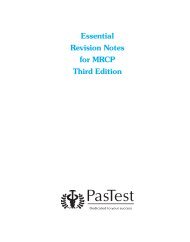OSCEs for Medical Students, Volume 3 Second Edition
OSCEs for Medical Students, Volume 3 Second Edition
OSCEs for Medical Students, Volume 3 Second Edition
You also want an ePaper? Increase the reach of your titles
YUMPU automatically turns print PDFs into web optimized ePapers that Google loves.
124 <strong>OSCEs</strong> <strong>for</strong> <strong>Medical</strong> <strong>Students</strong>, <strong>Volume</strong> 3AnswersCommentThe abdominal examination is relatively easy to set up <strong>for</strong> an OSCE station, as thereare many children with stable splenomegally, jaundice, nephrotic syndrome andconstipation. As with the other systems to be examined, observation is the key. Herethis means systemic signs – jaundice, anaemia and weight loss, and looking <strong>for</strong>abdominal distension, visible peristalsis and scars. Ensure that you look <strong>for</strong> inguinaland renal scars. A competent examination should always be directed towards thepresenting complaint – in this case distension. Causes could be organomegaly, amass, constipation or ascites. <strong>Students</strong> frequently <strong>for</strong>get to properly examine thegroin, anus, penis and testes. You will not be required to do a paediatric rectal, butyou should offer to look at the perianal area and genitalia.Other openers <strong>for</strong> a paediatric abdominal examination are jaundice (look <strong>for</strong> othersigns of liver involvement, measure liver span) and weight loss. (Also look at bodyfat, listen <strong>for</strong> a murmur and <strong>for</strong> signs of chest involvement in CF.)
















